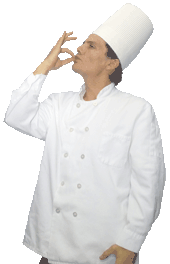A larding needle is a needle which is designed to push fat into meats for cooking in a process known as larding. Larding is a very old technique for keeping meats moist and flavorful during the cooking process, and it continues to be called for in some recipes. Lard is the traditional choice of fat for this cooking technique, since it is cheap and readily available, although other rendered fats may be used as well. A related cooking technique, barding, involves wrapping meats in strips of fat, rather than forcing the fat into the meat.
A typical larding needle has a very sharp tip and a hollow body. A strip of fat or lard is forced into the larding needle, and then the needle is pushed through the cut of meat to be larded. As the larding needle passes through the meat, it leaves the strip of fat behind. In a sense, larding could be viewed as a form of artificial marbling, lacing a meat with fat so that it will cook to perfection.

Some cooks use a U-shaped larding needle which works in much the same way as a regular larding needle. Many larding needles also come equipped with small teeth for gripping the piece of fat as it is run through the meat. Cooks can also accomplish larding by injecting lard into a cut of meat with a large-bore needle, as long as they remember to carefully pull the needle out as they force the lard through to avoid making a large deposit of lard in a small area.
As larded meats roast, the lard keeps the meat moist and infuses it with flavor. The fat will slowly render out of the meat so that it does not end up tasting greasy or fatty. Since dryness is a major issue with roasted meats for many people, especially large roasts, larding can be a useful kitchen technique to experiment with. Many classic cooking texts such as The Joy of Cooking and the words of Julia Child can help you learn larding techniques.
Seasoned fats are popular choices for larding since the seasoning will infuse the meat while it cooks. Lard can be blended with herbs, spices, or ingredients like garlic for a rich time released flavor. By using a larding needle, the cook can ensure that the seasoning penetrates the meat, rather than remaining on the surface as is the case with things like rubs.
